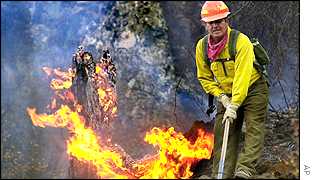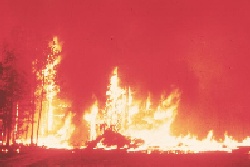General information index. Also see
current hazard mitigation
Wildfires, also known as forest fires, are often a naturally occurring hazard
that faces every community. While they do occur naturally, usually started
by lightning, more often the cause is man made. A camp fire, a smoldering
cigarette or sparks from someone burning brush or trash.
The North
Carolina Department of Environment and Natural Resources, Division of Air
Quality says "there are a lot of misunderstandings about open air
burning in North Carolina. Some people think it is okay to burn trash in
barrels because they have always done it that way. It's not! Others think it
is always okay to burn leaves and branches in the fall, but that is not so
in cites and counties that pick up yard waste".

Alexander County and NCDFR have jointly developed a number of pro active mitigation measures to reduce the vulnerability to wildfire.
 The
Division of Forest Resources has the responsibility for protecting state and
privately owned forest land from forest fires. The program is managed on a
cooperative basis with the counties. All one-hundred counties participate in
the forest fire protection program. Emphasis in the fire program include
fire prevention efforts; pre-suppression activities (including extensive
training of Division and non-Division personnel); aggressive suppression
efforts on all wildfires; and law enforcement follow-up.
The
Division of Forest Resources has the responsibility for protecting state and
privately owned forest land from forest fires. The program is managed on a
cooperative basis with the counties. All one-hundred counties participate in
the forest fire protection program. Emphasis in the fire program include
fire prevention efforts; pre-suppression activities (including extensive
training of Division and non-Division personnel); aggressive suppression
efforts on all wildfires; and law enforcement follow-up.